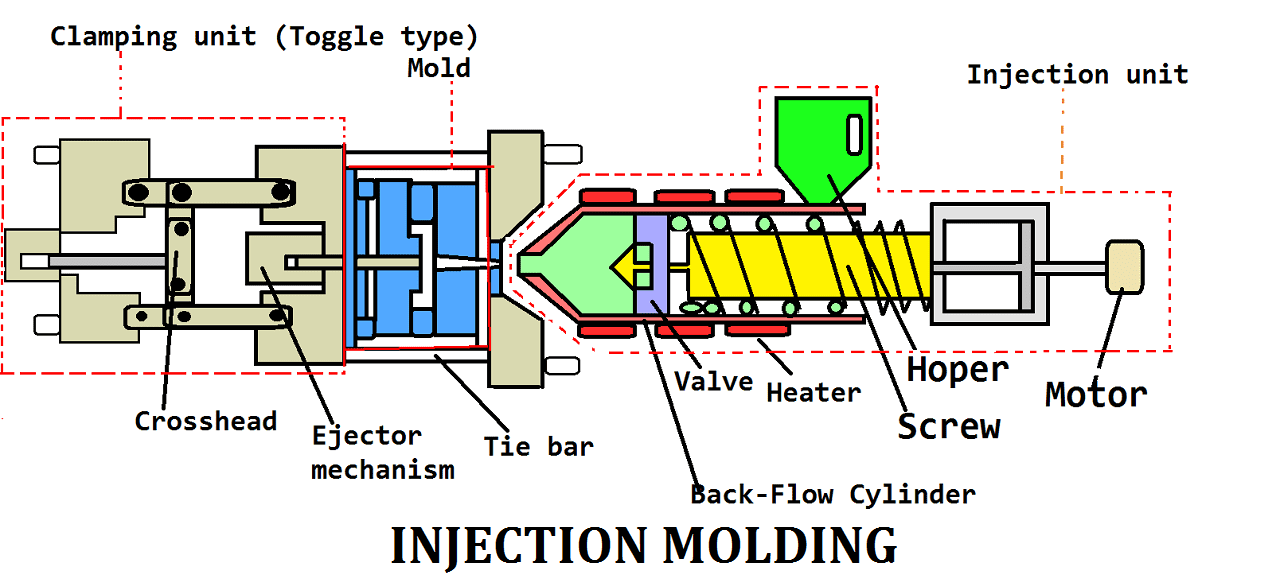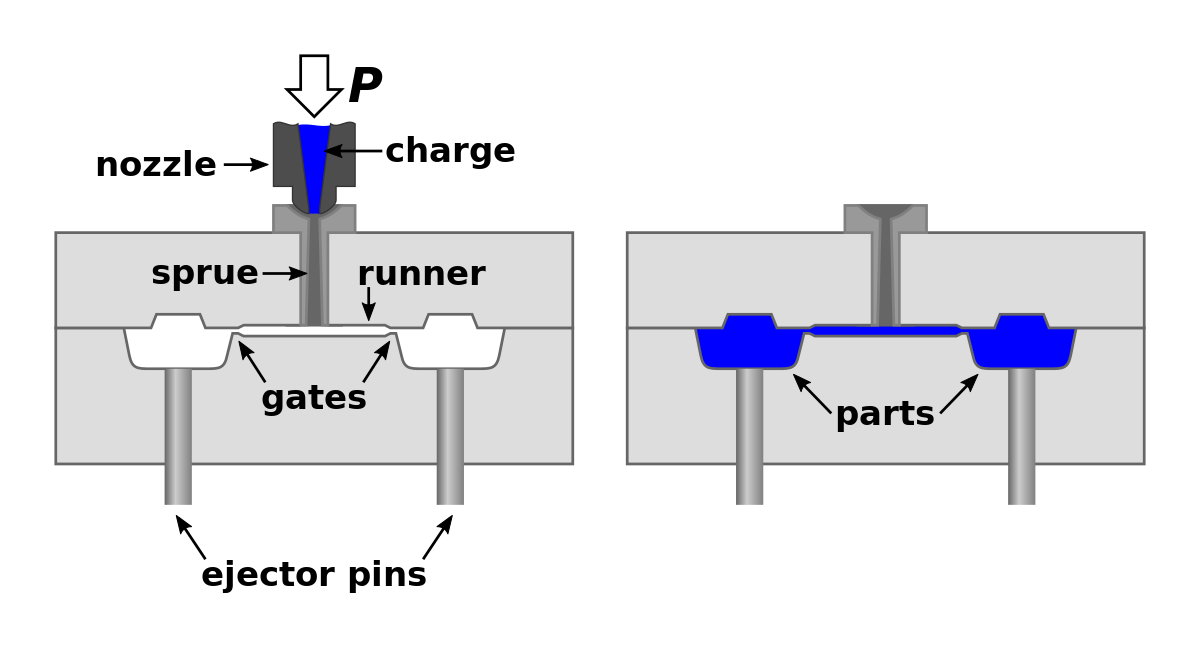Injection moulding is a manufacturing process that allows for parts to be produced in large volumes. It works by injecting molten materials into a mould. It is typically used as a mass production process to manufacture thousands of identical items. Injection moulding materials include metals, glasses, elastomers and confections, although it is most commonly used with thermoplastic and thermosetting polymers.
How does it Work?
The first stage of injection moulding is to create the mould itself. Most moulds are made from metal, usually aluminium or steel, and precision machined to match the features of the product they are to produce.
Once the mould has been created by the mould-maker, the material for the part is fed into a heated barrel and mixed using a helical shaped screw. Heating bands melt the material in the barrel and the molten metal or molten plastic material is then fed into the mould cavity where it cools and hardens, matching the shape of the mould. The cooling time can be reduced through the use of cooling lines that circulate water or oil from an external temperature controller. Mould tools are mounted on plate moulds (or ‘platens’), which open once the material has solidified so that ejector pins can eject the part from the mould.
Separate materials can be combined in one part in a type of injection moulding called a two-shot mould. This technique can be used to add a soft touch to plastic products, add colours to a part or produce items with different performance characteristics.
Moulds can be made of single or multiple cavities. Multiple cavity moulds can have identical parts in each cavity or can be unique to create parts of different geometries. Aluminium moulds are not best suited to high volume production or parts with narrow dimensional tolerances since they have inferior mechanical properties and can be prone to wear, deformation and damage due to the injection and clamping forces. While steel moulds are more durable they are also more expensive than aluminium moulds.

How Can I Reduce Mould Costs?
Injection moulding can be an expensive process, but there are several ways in which you can reduce mould costs, including:
- Eliminate undercuts
- Remove unnecessary features
- Use a core cavity approach
- Reduce cosmetic finishes
- Design parts that self-mate
- Modify and re-use existing moulds
- Monitor DFM analysis
- Use a multi cavity or family type of mould
- Consider your part sizes
When is Injection Moulding Used?
Injection moulding is used to make a range of widely used products, including common plastic items like bottle tops as well as remote control casings, syringes and more. It is also commonly used for manufacturing larger items such as car body panels.
Injection moulding is mainly used where there is a need to manufacture many thousands or millions of identical parts from a mould.
Types
There are many different injection moulding process variations, including:
- Cube moulding
- Die casting
- Gas-assisted injection moulding
- Liquid silicone rubber injection moulding
- Metal injection moulding
- Micro injection moulding
- Reaction injection moulding
- Thin-wall injection moulding
Materials Used
Injection moulding can be performed with a variety of different materials including metals, glass, elastomers, confections and, most commonly, thermoplastic and thermosetting polymers.
Materials can be combined to deliver different properties and effects for the finished parts.
Advantages
The main advantage of injection moulding is being able to scale up production to produce a large number of parts. Once the initial costs of the design and the moulds have been covered, the price of manufacturing is very low. The cost of production drops as more parts are produced.
Injection moulding also produces minimal wastage when compared to traditional manufacturing processes like CNC machining, which cuts away excess materials. Despite this, injection moulding does produce some waste, mainly from the sprue, the runners, the gate locations, and any overflow material that leaks out of the part cavity (also called ‘flash’).
The final advantage of injection moulding is that it allows for the production of many identical parts, which allows for part reliability and consistency in high volume production.
Disadvantages
While injection moulding has its advantages, there are also a number of disadvantages with the process.
Up-front costs can be high for injection moulding, particularly with regard to tooling. Before you can produce any parts, a prototype part needs to be created. Once this has been completed, a prototype mould tool needs to be created and tested. This all takes time and money to complete and can be a costly process.
Injection moulding is also not ideal for producing large parts as a single piece. This is because of the size limitations of injection mould machines and the mould tools. Items that are too large for an injection moulding machine’s capability need to be created as multiple parts and joined together later.
The final disadvantage is that large undercuts require experienced design to avoid and can add even more expense to your project.
Applications
Injection moulding is used for a range of applications where a repeatable manufacturing process is required. This includes manufacturing items such as wire spools, packaging, bottle tops, toys, combs, musical instruments (and components), chairs, small tables, storage containers, mechanical parts, and automotive parts and components.
Injection moulding is the most common method for manufacturing plastic parts, particularly in high volumes.
What Plastics are used in Injection Moulding?
With over 85,000 commercial plastic material option available and 45 polymer families, there is a wealth of different plastics that can be used for injection moulding. Of these, the polymers can be broadly placed into two groups; thermosets and thermoplastics.
The most common types of plastic used are high-density polyethylene (HDPE) and low-density polyethylene (LDPE). Polyethylene offers a number of advantages including high ductility levels, good tensile strength, strong impact resistance, resistance to moisture absorption, and recyclability.
Other commonly used injection moulded plastics include:
1. Acrylonitrile Butadiene Styrene (ABS)
This tough, impact-resistant plastic is widely used across industry. With good resistance to acids and bases, ABS also offers low shrinkage rates and high dimensional stability.
2. Polycarbonate (PC)
This strong, impact resistant plastic has low shrinkage and good dimensional stability. A transparent plastic that is available in different optically clear grades, PC can provide a high cosmetic finish and good heat resistance.
3. Aliphatic Polyamides (PPA)
There are many different types of PPA (or nylons), each of which has its own advantages. Generally-speaking, nylons offer high strength and temperature resistance as well as being chemically resistant, apart from against strong acids and bases. Some nylons are abrasion resistant and offer good hardness and stiffness with good impact strength.
4. Polyoxymethylene (POM)
Commonly known as acetal, this plastic has high hardness, stiffness, strength and toughness. It also has good lubricity and is resistant to hydrocarbons and organic solvents. Good elasticity and slipperiness also provide advantages for some applications.
5. Polymethyl Methacrylate (PMMA)
PMMA, also known as acrylic, provides good optical properties, high gloss and scratch resistance. It also offers low shrinkage and less sink for geometries with thin and think sections.
6. Polypropylene (PP)
This inexpensive resin material delivers high impact resistance in certain grades but can be brittle in cold temperatures (in the case of propylene homopolymer). Copolymers offer greater resistance to impact while PP is also wear-resistant, flexible and can provide very high elongation, as well as being resistant to acids and bases.
7. Polybutylene Terephthalate (PBT)
Good electrical properties makes PBT ideal for power components as well as automotive applications. The strength ranges from moderate to high depending on glass fill, with unfilled grades being tough and flexible. PBT also shows fuels, oils, fats and many solvents, and it also doesn’t absorb flavours.
8. Polyphenylsulfone (PPSU)
A dimensionally stable material with high toughness, temperature and heat resistance, PPSU is also resistant to radiation sterilisation, alkalis and weak acids.
9. Polyether Ether Ketone (PEEK)
This high temperature, high-performance resin provides heat resistance and flame retardancy, excellent strength and dimensional stability, as well as good chemical resistance.
10. Polyetherimide (PEI)
PEI (or Ultem) offers high temperature resistance and flame retardancy, along with excellent strength, dimensional stability and chemical resistance.
Conclusion
Injection moulding has a great many applications for manufacturing, particularly for producing high volume parts. While the tooling and moulding can be expensive, the cost of production once this is completed is low. Providing the ability to produce near-identical parts, injection moulding is used for parts in a variety of material types.